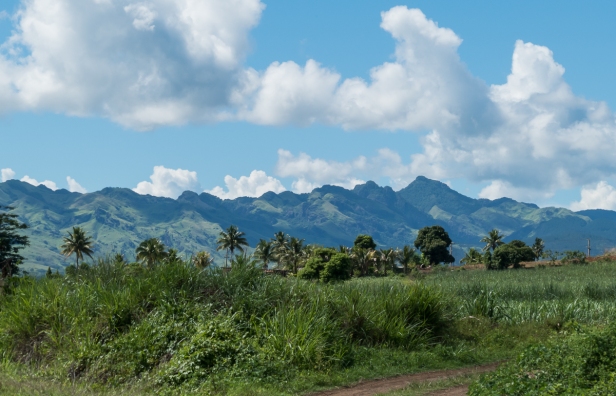
14 December 2014. There’s a notion going around that the world is a small place, brought about no doubt by our increasing access to stories, photographs and videos of, well, pretty much everywhere. But it’s not small really. Well relative to a galaxy I suppose it is, but relative to the size of a human being it is a very very large place and to see even a tiny part of it, and of the communities of people who inhabit it, vast distances must be travelled.
From the west coast of Canada we crossed the Pacific, a distance of some nine and a half thousand kilometers, to Fiji, a group of tiny islands in the middle of an immense ocean. We landed in Nadi on Viti Levu, Fiji’s main island. Up in the Ba Highlands of Viti Levu, about three hours by car north-west of Nadi, past the Indo-Fijian town of Ba, over increasingly narrow and winding roads, is the remote traditional village of Navala. It is the only remaining traditional village on Viti Levu though there are others on some of the more distant of Fiji’s 333 islands. Here in this village, nestled in the mountains, and frequently isolated by a flooded river, is a community of some eight hundred souls living a simple quiet life.
We drove there with our guide on a fine sunny day in December, gradually heading inland, away from the coast, up into the highlands, past sugar cane plantations, and past a landscape that became more and more mountainous, and more and more spectacular.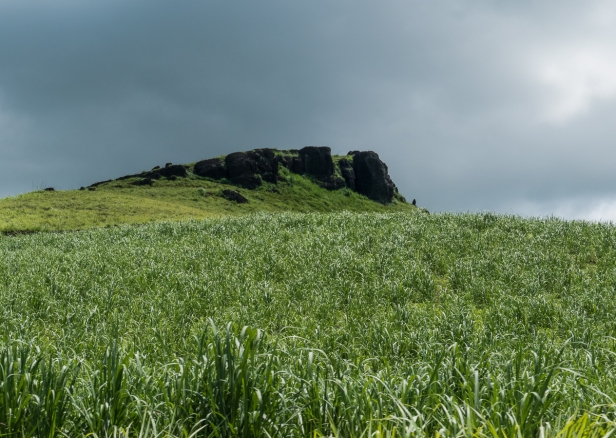


Rich emerald-green-and-blue-mountain beauty unfolding forever and filling the senses. That alone would have been enough. Then there, suddenly, spread out before us, was the village.
The people of Navala live in traditional thatched bures and in this lush beautiful environment they lead quiet subsistence lives farming the land.

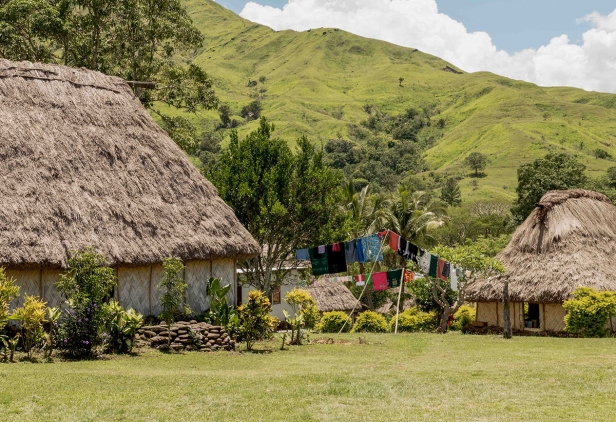
Upon arrival we were introduced to a young girl who was to be our guide around the village. It was just Don and myself that day on our own personal tour. We were lucky to be visiting on a Sunday since it meant everyone was at home.
We were shown around the entire village and our guide shyly answered all our questions. She told us the men of the village hunt wild pigs with spears and dogs every Saturday so there is a big pig roast once a week. She told us that over a nearby hill is the plantation where they grow cassava, taro, yams, kava, guava, mango, and papaya. She told us each family has goats, cows, bulls, and horses, though the livestock was not in the village. She showed us the school and the church, two of the very few buildings that are not thatched bures. They also have limited electricity from generators that are housed in sheds.
What we discovered for ourselves is that the people of Navala Village are charming and open and very friendly.

Most of the kids wanted to be photographed and pushed and shoved to be included.

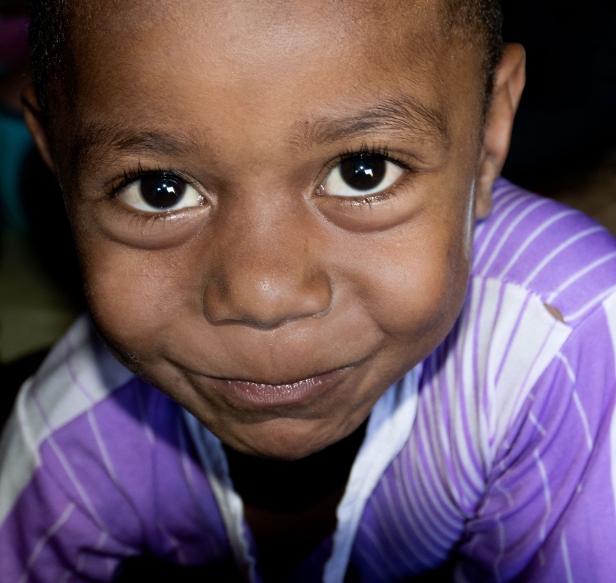
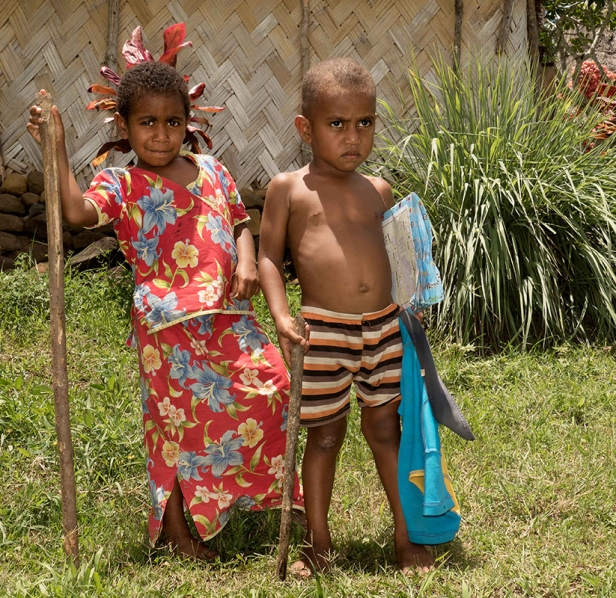


What better place to play, or bathe, on a hot day.

We were taken to meet the chief. He sat in his house, leaning against the centre pole. I wonder if he’s as fierce as he looks in this picture.
There were several men with him.
We were invited to join in tasting kava, a ritual drink of the Polynesian islands. Kava is the pulverized root of a plant related to pepper, mixed with water. It makes your tongue numb and your mind mellow. The coconut-shell cup is passed around in an hierarchical order, and each person claps once before and once after drinking. Everyone drinks. Everyone gets mellow.
The men in the chief’s house preparing the kava:
After tasting the kava we continued our tour of the village. This is a cooking area outside one of the bures.
There are almost two hundred bures in the village. They are built of bamboo, directly on the grass-covered earth. The roof thatch is made from reeds, the walls are woven bamboo and the floors are covered in woven pandanus mats.

Finally it was time for lunch. One of the families had opened their home for us and we were welcomed in. First we were invited to join in another kava ceremony, and once again the cup was passed around accompanied by the ritual clapping.
Then we were invited to eat from a sumptuous spread. We felt a bit awkward eating alone in front of everyone, but clearly that was what was expected. After we’d finished it was the kids’ turn to tuck in.

Navala village has been in existence since 1949. In 1950 the community decided to reject modern housing options and to continue the traditional ways, teaching the young the art of bure construction. Although there are small numbers of visitors every day, and the income from tourists for maintenance of, and improvements to the village is most welcome, their way of life is chosen and authentic. The remoteness of the village helps keep it that way. We were very glad we went. The drive was through the spectacular scenery of Viti Levu’s hinterland,
and our time in this gentle village gave us a glimpse into a more peaceful and grounded way of life. Using what the land provides for shelter, food and water, the people of Navala live in harmony, close to each other, and close to the earth.
In this very large world, hidden away in the highlands of a tiny island in an enormous ocean, lives a small group of people, farming the land and husbanding their animals, and welcoming anyone who cares to visit them.
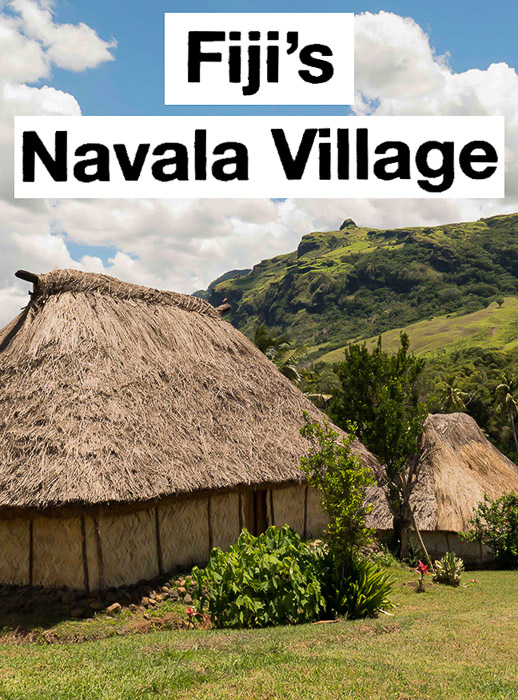
Next post: Orchids galore. The beach. The fire dance. More of beautiful Fiji.
All words and images by Alison Louise Armstrong unless otherwise noted
© Alison Louise Armstrong and Adventures in Wonderland – a pilgrimage of the heart, 2010-2015.

Beautiful place, beautiful photos, thanks! I love Fiji and its people and would really like to return some day. Did you get to Taveuni?
LikeLike
Thanks so much Caroline. We loved Fiji too, and return for a couple of days in May. We didn’t get to Tavenui, we only had a couple of days there on our way over the Pacific to avoid long flights and jet lag. Same for the return. Since we both love the tropics so much perhaps we should plan a future longer stay in the South Pacific islands!
LikeLike
Best one yet. I want to be a part of building something like this somewhere. A friend has found some land in Costa Rica!
LikeLike
Wow, thanks Ross.I think Costa Rica would be fabulous for such a place. Hope you get to do it.
Alison
LikeLike
There is something you will know for sure when you die, and that is that you fully lived. How many people can say this? You are my soul sister. And you show us all such beauty. Thank you both immensely for the way you live, and the beauty you give.
LikeLike
Cindy ❤ ❤ Thank you so much for your lovely words ❤
I love sharing our journey. There's so much richness and beauty in the world.
Yes, soul sisters. I know you have such a deep connection to nature, and to this beautiful planet we get to hang out on. It is such a blessing just to be here!
Alison
LikeLike
Such bright beautiful smiles.
LikeLike
Thanks Angeline. Oh they were full of smiles! Both adults and kids, but especially the kids. And we were lucky to be there on a Sunday otherwise most of the adults would have been at their plantation and the kids in school.
Alison
LikeLike
Thank you for bringing me to
an island paradise
& the happy people
and other life co=existing there,
beautifully in harmony 🙂
LikeLike
Thank you, and you’re welcome! It is my pleasure to share 🙂
A simple life, close to the land, much harmony.
Alison
LikeLike
Looks like a really great village with such great people too. The photos are quite good and the images of the children, simply priceless. Such innocence and happiness captured in each child’s face.
LikeLike
Thanks Diana. It is indeed a great village. So glad we went there. The children were a total delight.
Alison
LikeLike
Great post! Thanks
LikeLike
Thank you so much. I’m glad you enjoyed it.
Alison
LikeLike
You are very welcome Alison. Yes indeed I enjoyed it very much! Beautiful pics and story!
LikeLike
Beautiful! You keep surprising and delighting us with your rich experiences. You certainly know how to live life to the fullest. So happy for your!
LikeLike
Thank you so much Helga. We really enjoyed this little village tucked away in the mountains. It’s true we do go searching for such experiences as this, but still we are continually amazed by our life. It feels like we’ve been given a blessing, or won the lottery or something.
Alison
LikeLike
Although I’ve got so much going on I have promised myself that I’ll go there one day, cannot wait.
LikeLike
Yes, do go there Danny. Fiji and the other South Pacific islands are really special. I’ve briefly visited Tonga and New Caledonia many years ago, and a few years ago Don and I spent a week in The Cook Islands. On this trip we spent a week in Samoa, and a few days in Fiji. All of them wonderful.
Alison
LikeLiked by 1 person
I saw a travel programme featuring Reunion Island and always fancied going there too.
LikeLike
What a beautiful place… no pollution, no crowd, absolutely serene 🙂
Great to see that you were able to feel the local life so close and interact with them.
Thank you so much for sharing this beautiful post and have a great time 🙂
LikeLike
Thanks, Sreejith, and you’re welcome! Yes, it is a beautiful place. Serene is a good word for it.
Alison
LikeLike
Thanks for sharing, it feels like I´m part of it,
so beautyful pics
LikeLike
You’re welcome. And thank you. I’m glad you could feel a little as if you were there. It’s a beautiful place.
Alison
LikeLiked by 1 person
So with such a large world, how did you hear about and decide to visit this lovely place?
LikeLike
That’s one of my questions too.
My other question — it seems from your description that they speak English. Is that so? It’s surprising, given their isolation in that remote village.
It’s wonderful that these people can make, and stick to, a decision to maintain their culture and traditional lifestyle in such a committed, yet joyful, way.
LikeLike
There were many tourist brochures at the beach hotel where we stayed. Many many different opportunities to do and see things. We chose this. And on our second day in Fiji we went to an orchid garden. We have two more days in Fiji in May and we will choose a couple of other excursions. It seems the best way to get a bit of a feel for the country instead of hanging out at the beach all day. I’m always interested in indigenous cultures.
All Fijians speak English and Fijian, and of course the Indo-Fijians also speak Hindi. Our guide/driver said he spoke about 8 languages that included the above 3 and several Fijian dialects.
I agree about the way they’re committed to their lifestyle. They really did seem content.
Re the people of the village speaking English – the school in the village covers grade 1 thru 8, and the older kids travel by bus (one hour each way) to the town of Ba for the higher grades. Presumably English is taught in schools, as well as being spoken at least somewhat at home.
Alison
LikeLiked by 1 person
What a beautiful post. I loved the way you wrote about your visit, and of course the photos are superb.
LikeLike
Thank you so much Felicity. I’m so glad you enjoyed it.
Alison
LikeLike
I hope to visit there one day. Did you happen to see an international school on the island? I have heard that there is, but that finding a job there is really hard because nobody wants to leave!
-Amanda at http://teachingwanderlust.com/
LikeLike
We didn’t see an international school, but it wouldn’t surprise me a bit if there was one in Suva (the capital) at least. I can understand that no-one would want to leave! Still, Fiji is worth seeing. It’s a beautiful place.
Alison
LikeLike
Such beautiful fabrics!
LikeLike
Aren’t they! Love those Polynesian designs, so colourful.
Alison
LikeLike
Did you ask your guide if the young people (18-25) decide to remain in their ancestral way of life, or are they interested in seeing more of the world (or island) as the young usually wish to do? There appeared to be more women and children in the photos you selected, the men in the drinking ceremony photos don’t look to be all that young. Just curious.
LikeLike
We did not ask, and as you pointed out there were few young men there. Perhaps they were out in the fields. I would think there would have to be some who live there.
Alison
LikeLike
I really enjoyed reading through this. Seeing a modern-day life with such harmony with the Earth makes me yearn for that myself. That those communities still exist makes me happy. What a great journey to have experienced!
LikeLike
Thanks Dan. It makes me happy too that such communities still exist. It was wonderful to go there and see it first hand.
Alison
LikeLike
Wow what an amazingly beautiful village! The people look happy ! 😊 how long were you in Figi? Is there a lot of poverty? It looks like a wonderful place.
LikeLike
Isn’t it beautiful?! The surroundings are so gorgeous, and the people certainly seemed content, and delighted to have us there. Yes, a wonderful place.
We only had two days in Fiji (and two more on our return journey in May) so I don’t know a lot about it. I have a friend (Australian) who lived there for many years during the 70’s working for the Fijians but paid by the Australian government. I know Australia has given a lot of aid to Fiji over many years, and maybe still does. Yes, I do think there is poverty there, though can’t say to what extent.
Alison
LikeLiked by 1 person
Alison, reading this post makes me think of a question I’ve been asking myself for quite some time. We, as travelers, are always enchanted by traditional villages — those where centuries-old rituals are still performed and people still live the same way of life as their ancestors did. And we call it an ‘authentic’ experience. But sometimes I wonder if they actually deserve the very comfort of modernity we all enjoy, making life much easier for them. But then it all comes down to the basics: happiness and well-being are two important things we all should look forward to living. From your story, it sounds like the people of Navala are happy with their current way of life… and happiness is something many of us have been looking for.
LikeLike
Thank you so much for your thoughtful comment Bama. It really got me thinking about it.
I think many important things have been lost in society at large by the ‘comfort and modernity’ we all enjoy. This does not necessarily apply to all people, but it does to many, especially those living in big cities the world over, who, for example, seem to think shopping is a valid hobby, and live in constant debt to pay for those modern comforts.
What seems to have been lost is a sense of community and the comfort derived from that, a sense of connectedness to the earth, a sense of connectedness to spirit, a sense of place, and a sense of belonging, and because of all that a great loss of inspired and joyous creativity.
Above and beyond the essentials of good shelter, clean water, and enough to eat I think all these things are more important than modern comforts, and seem to better fulfill the requirements for happiness and well-being. Perhaps that is why we are so drawn to these kinds of communities.
I love that our tourist dollars help these kinds of communities to continue in their traditional ways, and we travel not to see the same things we can see at home, but to see, and be inspired by, the infinite number of different ways people do life.
Phew! I never knew all that was going to come out! As I said, your comment got me thinking. And I must also say that I thoroughly enjoy the comforts of modernity and would not willingly give them up.
Alison
LikeLiked by 1 person
Bama and Alison, these are such difficult questions to ponder, especially for those of us who do have the comforts of modernity and yet look so hard for the places that don’t! I so agree with you, Alison, about what we have lost as we grow ever fonder of the trappings of modernity. And Bama, the one thing I might have learned from years of travel and work with communities less developed and “modern” than my own is that we modern people have no ability (or right) to assume that others would be better off with the things we have. I know you were not necessarily saying that, but it’s so hard to not let our own cultural expectations and assumptions color our view of other communities. I loved seeing this happy, connected community, Alison!
LikeLike
I agree they are very difficult questions to ponder. Where does one draw the line? The people of Navala were very happy to have the money to install showers quite recently, but I think it would be somehow destructive to the fabric of their society to put them all in modern housing. On the other hand perhaps a communal kitchen with modern facilities would be most welcome. But they would still have to cook over fire unless they would have a propane or electric stove which implies the cost of fuel either way. Again, where do you draw the line between having modern comforts, but not so much that the essence of their community is lost? I also agree we have no right to assume others would be better off with the things we have.
I d get what you’re getting at Bama, but I think there’s no clear answer.
Alison
LikeLike
By traveling we learn that happiness is much more than just staying up to date with the latest fashion style and gadgets. Thanks a lot for this long, but important message for us all, Alison.
LikeLike
Oops! I mean Bama! So sorry.
A.
LikeLike
Your write-up reminds me of the song,”Heaven is a place on Earth”.
And the word Kava takes me back to my childhood, when I had read that original Kava used to be prepared by a ceremonial girl who chewed the roots. It preparation used to be ritualistic. Colonial rulers looked down upon the pratice of mastication of the root and the custom died out. Today the roots are ground. Thanks for reminding me of my first encyclopedia 🙂
LikeLike
That’s so interesting about the kava being chewed as a ritual. I hope the girl who did the chewing was properly honoured. Colonial rulers looked down on a lot of things! No chewed up kava root these days – we saw them pouring in the powdered root.
I definitely think “Heaven is a place on Earth” – many places actually, and this seemed to be one of them.
Alison
LikeLiked by 1 person
Women were highly regarded in many polynesian societies. The chewing was done was community members and some records state that the people selected to chew were supposed to have a good set of teeth and healthy.
Polynesia has been on my list for a long time… will surely visit Fiji when i am there. Thanks again…:)
LikeLike
A –
Thank you so much for the glimpses, here. On this Friday morning off, I not only get to not rush about, but to visit whole other ways of being, to relish in the beauty and smiles of some kindred folk so very far away, to expand with the views into the variety of landscape and human construction beyond my local gaze – and to ponder the smallness and largeness of the world at once. Heart grateful for your shares. Can I visit again in May here with you? 🙂 xo!! marga
LikeLike
Thanks Marga. So glad I could take you on a little journey to this sweet far away place.
You don’t have to wait til May. There’s another post on beautiful Fiji coming in a week!
Alison ❤
LikeLike
I love that your post got people pondering the alchemy of happiness in the world. You continually read travel writers saying how happy the locals are “despite” modern conveniences. Anyone who has traveled to places like this sees the smiles and senses the genuine friendliness and happiness in the people, perhaps not “in spite” of the fact that they have no, or only a few, modern conveniences, but “because” they have none. Local Bataks on Samosir Island were some of the happiest people I’ve come across, and they had no running water, they bathed in the lake, every day. Your photos in this post were very lyrical. You had great lighting. I loved the ones with black backgrounds, but also the ones that showed a range of light and faded off into white, outside the hut.
LikeLike
It’s such a fine line I think between having so much of modern conveniences that the true essence of the society is lost, and not enough so that life is more of a struggle than it needs to be. The people of Navala certainly seemed happy, and I imagine any group of people that can bathe in a lake every day would derive a certain level of groundedness and joy just from being able to do that. When we lived in a village in Mexico for 4 months we had a very private swimming pool and one of our greatest pleasures was being able to be in the water every day. Thanks re the photos. All were improved greatly by LR!
Alison
LikeLike
I spent a couple of weeks on Fiji and really enjoyed the island and its people, Alison. It was a long time ago but i still remember the smiles. Thanks for the reminder. –Curt
LikeLike
You’re welcome! I also visited Fiji (3 times) many many years ago, and was happy to return. Lovely islands and plenty of lovely smiles!
Alison
LikeLike
Not to mention those wonderfully sharpened teeth. Did you visit the cannibalism museum, fascinating if a little creepy. –Curt
LikeLike
No we didn’t. I’m guessing it’s in Suva. Because we only had 2 days we didn’t go much beyond Nadi. Creepy or not, I would love to see a cannibalism museum 🙂
A.
LikeLike
For example, their are special forks for eating people. We (my first wife and I) were taken through the museum by a wonderful guide who would point out something and then laugh at our reactions, showing his full set of filed down and very sharp teeth. 🙂 One of the interesting stories was about the first Bishop to come to Fiji and try to force the locals to change their ways. He was divided up and sent all over the island so everyone could partake in the feast. –Curt
LikeLike
I laughed in horror when I read this. Would no doubt not be laughing had I been their victim however! And the guide sounds wonderfully appropriate 🙂
A.
LikeLike
I remember visiting the museum in Adelaide in the early 1980s. It had an exhibit featuring the tribes of the Pacific who ate “long pig.” It was fascinating.. like stepping into an exhibit from the 1950s. I am sure the exhibit is long-gone, considered no longer to be culturally acceptable. Perhaps that is true, but a fascinating insight none-the-less.
LikeLike
That must have been a very interesting exhibit!
A.
LikeLike
It was certainly one of those experiences that forever sticks in you mind, Alison. 🙂 –Curt
LikeLike
Alison, there’s nothing like some flight time across the Pacific to remind you that it really isn’t such a small world after all. On our last crossing, we deliberately stopped for a week in Hawaii to take a break. It turned out so well stopping midway is probably going to be our approach in the future. Each one of these long, long flights seems to take a little more out of me. ~James
LikeLike
I think we’ll do the hop across the Pacific in future too, it worked so well this time. Five days in Hawaii, 6 in Samoa, and 2 in Fiji – no jetlag, and no brutal 14 hour flight, plus we got to visit some neat places along the way. And, yeah, we don’t do so well with the long flights any more either.
Alison
LikeLike
Hi Alison and Don I loved the writing style very touchy photos as well….
I have come across one more blog which has great information…..If you wnat to have a look https://thetraveler289.wordpress.com/
LikeLike
Thank you Onkarnath for your kind words. The blog you mentioned does look very good.
Alison
LikeLike
I have been here! To this village and taken part in the kava ceremony. It was a really amazing day and I loved it. Great post!
LikeLike
Thanks Shelley. Yes, it was a really amazing day! So glad we chose to go there.
Alison
LikeLike
Interesting post. It is always a conundrum as to how to keep the balance between voyeurism and exploitation versus legitimate support. It seems as if this village has it about right for now.
LikeLike
I do think they have it right for now, and I hope they can maintain it. There is always a slight feeling of voyeurism just because of the circumstances, but we were so welcomed, and having visitors seemed such an accepted part of their life, that it felt okay.
Alison
LikeLike
So did the lava make you mellow?
LikeLike
Make that kava. Durn Kindle!
LikeLike
lol I wondered about lava. We didn’t drink enough of it to tell. Wish we’d had more 🙂
Alison
LikeLike
Kids the world over! 🙂 Love their smiles and their scowls too. What must it be like to be born into this community and oughtn’t we all to be able to live like this? I never saw a more beautiful place. Could I… would I… be content? I like to think so but I’m not much good at growing and making things 😦 Thank you so much. I have really enjoyed sharing your temporary world.
LikeLike
Thanks so much Jo. Everywhere we seem to go it’s the kids that break the ice. They’ve not yet developed the inhibitions of adulthood I guess. Certainly the people of this village have a unique life, and seem very content. I don’t think I could live like that though. Glad you enjoyed my meanderings.
Alison
LikeLiked by 1 person
Hey there! How can we get to this village by ourselves without the tour and is it possible to self drive there?
LikeLiked by 1 person
Yes it’s possible to drive there as that’s how we got there, you’ll find it on google maps. Be aware that you need to cross the Ba River just before the village and during the rainy season it will be flooded and impassable. I don’t know what would happen if you just showed up unannounced, and would recommend the tour. I do know some (all?) of the lunch we had was not provided by the village but brought in by the tour guide. Hope this helps.
Alison
LikeLike
This is beautifully written and such a heart warming story. I wonder how the kava tradition will survive in these times. I love that the kids pushed and shoved to be in the photos. Same in Africa!
You found such a lovely experience and I think these are the ones that make life richer and sweeter. Your photos are captivating.
LikeLiked by 1 person
Thanks so much Heather. I’m so glad we went to this place. It was a really sweet day, and the kids were adorable. We also found the same with the kids in parts of South America – a village in the Amazon springs to mind. I’m glad I was able to capture something go the feel of it.
Alison
LikeLiked by 1 person
What a beautiful post, along with some equally gorgeous photos. It sounds like a real honour to be able to visit & be welcomed by the people in such a way. It’s rare to be able to see this kind of traditional way of life anywhere in the world now so thank you for sharing. I felt mellow just reading it!
LikeLiked by 1 person
Thank you so much Sue. I’m glad you enjoyed it. Mellow is always good. It was such a beautiful day and I’m so glad we made the choice to go. I try to seek out more remote places. As you say it’s rare to see traditional life these days, and that’s what I find most appealing.
Alison
LikeLike